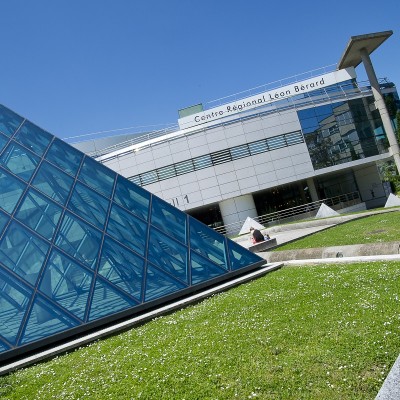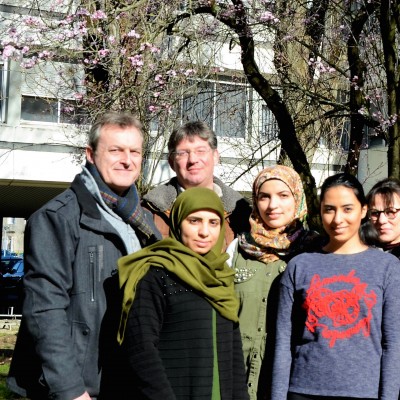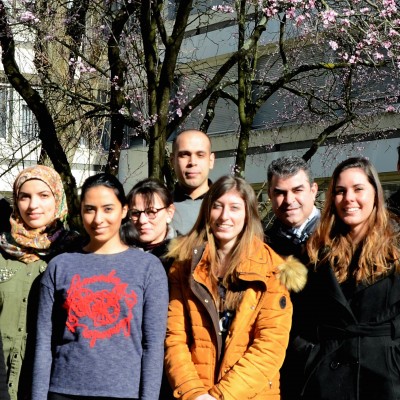Charity dedicated to the fight
against childhood cancer
against childhood cancer

You have decided to focus your research on childhood cancers. Can you tell us more about your motivations for working on childhood cancers?
I chose to focus my research on childhood cancers largely because of personal experience. During a conversation with my son about his friend's illness, I was intrigued by his childhood questions about cancers. He asked me if I worked on cancers, and I answered in the affirmative, explaining that I was looking for new treatments to cure them. However, he then asked me why I did not work specifically on childhood cancers.
It was at this precise moment that my son told me that one of his friends, Imene, had cancer, and that he hoped that I could work on this type of cancer to save her. This conversation deeply touched my heart and prompted me to make the decision to focus on pediatric cancer research. By a happy coincidence, at the same time, I had also made the decision to share my laboratory with the team of Dr. Birgit Geoerger, a pediatrician at Gustave Roussy.
Furthermore, after discussions with pediatric researchers at Gustave Roussy and the Curie Institute, it became clear that there was a pressing need to develop new treatments for pediatric cancers. This convergence of personal and professional elements strengthened my determination to dedicate my efforts to research on childhood cancers and to contribute to improving the prospects of cure for these young patients.
More specifically, can you tell us more about your project supported by Eva for Life? What types of cancers does it focus on? What are your hopes in terms of therapy?
Our project, supported by Eva for Life, focuses on the identification of new immunomodulatory molecules. These molecules are capable of inducing specific immune responses against cancer cells. In other words, we are working on substances that have the ability to stimulate cancer cells to produce antigenic peptides. These peptides can then be specifically recognized by the lymphocyte cells of the immune system, which leads to their multiplication and their ability to destroy cancer cells.
Our research project focuses on several types of pediatric cancers, including neuroblastoma, osteosarcoma and glioblastoma. These cancers are particularly serious and require innovative therapeutic approaches.
We started our project about a year ago, and we have already obtained promising preliminary results with some of our immunomodulatory molecules. Our ultimate goal is to protect these molecules through patents specific to pediatric cancers, which could open the way to new treatment options for children with these types of cancer.
Our therapeutic hopes are to develop more effective and targeted treatments for these serious pediatric cancers, by exploiting the potential of the immune system to fight cancer cells. We aspire to improve the prospects for cure and the quality of life of children affected by these devastating diseases.
Do you plan to develop this project with other researchers – including on an international scale – and extend it to other types of pediatric cancers?
We are currently in discussions with the RECAMO Institute in Brno, Czech Republic, to evaluate the effect of our immunomodulatory molecules on glioblastoma. This project aims to use our molecules on glioblastoma organoids and analyze their immunomodulatory effect on this specific tumor type. Glioblastoma organoids are tumor models that are able to faithfully reproduce the genetic, histological and morphological characteristics of each tumor.
This collaboration with the RECAMO Institute demonstrates our willingness to develop our project in partnership with other researchers, including on an international scale. We are open to the idea of extending our research to other types of pediatric cancers or to other research partnerships to contribute to the fight against childhood cancer.
Did you encounter any difficulties, financial or administrative, in launching this project? What does the financial support from Eva pour la vie allow you to do?
We did not encounter any major difficulties in launching our project, largely thanks to a close collaboration with Professor Birgit Geoerger, a pediatric researcher at Gustave Roussy. In addition, we received funding from INCa six months before receiving financial support from Eva pour la vie. This initial funding from INCa allowed us to hire a research engineer, which was a crucial step in setting up our project.
However, the financial support from Eva pour la vie has had a significant impact on our activities. Thanks to these funds, we have been able to undertake the selection of potentially immunomodulatory molecules for the treatment of pediatric cancers among our various molecules. In addition, we have started to conduct in vivo studies on mouse models of pediatric cancer, which represents an important step in our research aimed at developing new therapies.
Beyond the call for public generosity, Eva pour la vie has been driving forward an unprecedented approach in Europe since 2012 – now shared by many associations through the Grandir Sans Cancer federation – asking the State to create a fund dedicated to research into childhood cancers, as well as to improve aid for families of sick children. With Grandir Sans Cancer, she obtained the vote at the end of 2018 for an annual fund dedicated to this research of 5 million euros/year, and at the end of 2021, an additional 20 million euros. What do you think of this mobilization?
I think that the mobilization of Eva pour la vie and the Grandir Sans Cancer federation for research on childhood cancers is extremely commendable and important. The fight against childhood cancer is a crucial public health issue, and it is essential to mobilize resources to support research and improve support for families of sick children.
The creation of a fund dedicated to research into childhood cancers shows an awareness of the importance of this cause. Obtaining substantial funding is a significant step forward. These financial resources have already made it possible and will make it possible to finance fundamental research necessary to better understand pediatric cancers, develop new therapies and improve survival rates.
Additionally, improving support for families of sick children is equally crucial. Coping with a childhood cancer diagnosis is an extremely difficult ordeal for families, and they need emotional, financial and logistical support to get through this difficult time. Mobilizing support for these families is an important aspect of the fight against childhood cancer.
I therefore think that the mobilization of Eva pour la vie and the Grandir Sans Cancer federation is admirable, necessary, and the funds allocated to research and assistance to families are an important step towards better care for children with cancer in France and in Europe.
Scientific publications: find out more

Eva pour la vie supports the Adapted Physical Activity project for children treated for Cancer and Insulin Sensitivity APACIS, led by Professor Marlène Pasquet, pediatric onco-hemato-immunologist at the children's hospital of the Toulouse University Hospital and Justine Thomas, APA teacher and doctoral student, as well as the recruitment of an APA position within this department.



Eva pour la vie & Grandir Sans Cancer have decided to support the work of Dr. Célio POUPONNOT, at the Curie Institute, by funding the Project "Modeling of medulloblastoma using human cerebellar organoids and analysis of the effect of agricultural pollutants" through a grant. This research project includes a crucial environmental research component, the question of understanding in order to try to prevent being as important as the one that aims to better treat children with cancers ...


For more than 20 years, this teacher-researcher has been working on cancer. And it's been almost 10 years since he went to kidney cancer or renal cell carcinoma. By joining the team of Dr Christophe Grosset (Inserm, MiRCaDe team), he wanted to use his experience and take a new step forward by working on childhood cancer. He is the initiator of an ambitious project, which involves several surgeons, doctors and international researchers, on the study of nephroblastoma (or Wilms tumor) in children, co-funded by the association Eva pour la vie and Aidons Marina ...
Resistance to treatment is a major clinical problem, in particular in the case of osteosarcomas, bone tumors affecting children or adolescents. Indeed, chemotherapy, associated with surgery, is the central pillar of current treatment. However, many osteosarcomas are or become resistant to these antiproliferative drugs. Recurrences and / or the appearance of metastases are then frequent. 2 out of 5 patients cannot be cured! Osteosarcoma is therefore a pediatric cancer with a poor prognosis for which it is absolutely necessary to identify ways to counteract resistance to treatment in order to improve the chances of recovery for patients.


Since September 2014, Dr Martin Hagedorn has been leading a team of researchers (Caroline CAPDEVIELLE , Farah RAHAL, Justine CHARPENTIER and Mélissa MENARD) which devotes its research work to the identification of new therapeutic targets in brainstem tumors and to the improvement of its treatment methods. Work recognized by several European scientific teams & experts.

Dr Pasquier's research work mainly focuses on the repositioning of drugs which consists of testing, in new therapeutic indications, drugs already approved by the health authorities. The aim of this work is to identify new therapeutic targets for the most difficult to treat cancers and thus improve the care of patients suffering from these aggressive forms and refractory to treatment . In particular, pediatric cancers (neuroblastoma), brain tumors affecting children as well as adults (glioblastoma, medulloblastoma) as well as certain rare forms of cancer (angiosarcoma).
The work of the INSERM team co-directed by Dr Marie Castets (CR1 Inserm, HDR) and Dr Jean-Yves Blay (PUPH, HDR) focuses on cell death and cancers. Thanks to the support of Eva pour la Vie (55,000 euros) and other associations, this team is currently developing these lines of research on rhabdomyosarcomas, osteosarcomas and neuroblastomas ...

